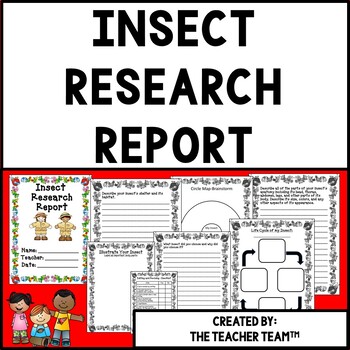Insects | Insect and Bug Research Report
- Zip
Also included in
- Engage your students with this fun and comprehensive, 75 page bundle containing two research reports; animals and insects! It helps make report writing easy! It contains, worksheets, questions, organizers, tools and forms to use for your students to create, develop, write, edit, illustrate, present,Price $7.00Original Price $10.00Save $3.00
- This blended resource is great for distance learning and in person learning. It contains materials for your students to complete an Insect and Bug Research Report. Combine resources to easily BLEND your classroom! This resource contains both a printable and digital - Google Slides Insect and Bug resPrice $7.00Original Price $10.00Save $3.00
Description
Engage your students with this fun and comprehensive, 34 page Insects Research Report resource. It helps make report writing easy! It contains worksheets, questions, organizers, tools, forms, and academic vocabulary for your students to create, develop, write, edit, illustrate, present, and assess your students’ Insects Research Report.
This report (or performance task) is also designed to not only to learn and explain the new information, but answer some higher level thinking questions (Common Core Essential Questions) to apply the knowledge they have learned.
This report packaged is designed to have your students choose one insect, to research it, and complete this report.
A simple rubric and student checklist is included. You can also add to this report by asking your students to do a model or large poster of their insect as well.
You can use this report template in its entirety, or “pick and choose” the questions that you wish to use and tailor it to your students’ needs. This package contains the following planet report elements:
1. Title Page- Templates Provided-Topic, student’s name, and teacher’s name - we
created gray-scale version if you can’t copy in color.
2. Which insect did you choose and why did you choose it?
3. Describe every part of the insect’s anatomy including its head, thorax, abdomen,
and other parts of its body. Describe its size, colors, and any other aspects of it
appearance.
4. Describe your insect’s senses and how does it know about what is happening
around them?
5. How does your insect make sound, describe the sound that it makes (if any) and
what is the purpose of this sound?
6. How does your insect breathe?
7. Describe the shelter and habitat of your insect.
8. Describe your insect’s life cycle.
9. How does your insect travel from place to place?
10. What does your insect eat and how did it get its food? Where is your insect in
the food chain?
11. How does your insect protect itself and does it do anything to camouflage itself?
12. What other insects is your insect closely related to?
13. How long does your insect live?
14. On which continents does you’re your insect live and how long have your
insects been living on our planet? Are there any fossils found of your insect and
where were they found?
15. Does your insect amazing strength? Can it jump far? What are some interesting
or special facts about your insect?
16. Compare and contrast your insect with another insect that interests you. What
are their similarities and differences?
17. Is your insect considered a harmful insect or a helpful insect? Write about how
humans view your insect and why they view it this way.
18. If you got to be a member of your insect’s species for a day, what would your
day be like? Describe what a typical day for your insect would be like, and how
would it be different than a typical day in your life?
19. Illustrate your insect. Draw a large picture and label the head, thorax, and
abdomen. Also label any other important body parts.
20. Illustrate your insects in its habitat.
21. Draw and label your insect’s life cycle.
22. A “Circle Map” has been included for your students to write down some basic,
preliminary information about the insect they chose.
23. Blank paper to add to any of the questions if more room is needed.
24. Additional Information page for any other facts not discussed in other areas of
the report if needed.
25. Ideas on how to research your report
26. Note taking bullet form template
27. Note taking lined form template
28. Resource pages and Bibliography Template
29. Student Checklist for editing and revising
30. Rubric for Performance Task Assessment
31. Common Core ELA Standard
32. Teacher Notes
If you like this product, please check back soon as we will be posting new products in the near future. If you have any questions or concerns, please do not hesitate to contact us and we will promptly help you. Thank you!
The Teacher Team
Here are some other items you may be interested in:
Social Studies Research Report Bundle
Animal Report Packet for Primary Grades
Biography Report Packet for Elementary Grades
Autobiography Report Packet for Elementary Grades
Digestive and Excretory System Research Report (For Elementary Grades)
Thirteen Colonies Regional Inquiry Based Research Report
Common Core Circulatory System Research Report for Fourth and Fifth Grades







